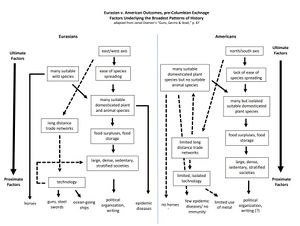Columbian Exchange
- the exchange, or transfer, or plants, animals, disease, people, and cultures to and from the Americas and the rest of the world
- followed the European discovery of the Americans by Christopher Columbus in 1492.
- the Columbian Exchange marks a dramatic turning point in world history with tremendous consequences upon world interactions and outcomes
Background[edit | edit source]
Columbus

Spanish conquest[edit | edit source]
- a core question about the Columbian exchange is why did the Spanish conquer the Americas in the Americas and one of the Native American empires did not invade and conquer Spain?
- Jared Diamond's "Guns, Germs and Steel" explores this question
- Diamond's analysis shows that the "broad" or very long-term causality of the outcome that that Spanish conquered the Americas and not the other way around is due to geography, notably:
- continental axis:
- east-west axis of Eurasia allowed for exchange
- north-south axis of the Americas limited exchange
- domesticable plants
- both regions had an abundance of domesticable plants
- but Eurasia had more available plants
- and given the east-west axis of Eurasia, those plants were spread
- therefore, Eurasian populations arose earlier than those in the Americas
- and centralized societies that might want to attack one or the other arose earlier in Eurasia
- domesticable animals
- the Americas lacked animals that are appropriate for food consumption and transport
- especially the horse
- many contageous diseases originated from human proximity to domesticated animals
- lacking those animals, the Americans had no immunity to Eurasian diseases
- the Americas lacked animals that are appropriate for food consumption and transport
- these combinations yielded advantages to Eurasian societies that the Spanish used in their conquest of the Americas, including
- technologies of guns and steel (used for weapons and tools)
- horses (war horses provided a considerable military advantage)
- disease, which killed off a tremendous number of Native Americans and weakened their centralized states
- continental axis:
Plants[edit | edit source]
- the most important exchange was
- deepest impacts include:
animals from the Americas[edit | edit source]
- turkeys
plants from the Americas[edit | edit source]
- beans
- chocolate
- maize (corn)
- potatoes
- sweet potatoes
- tomatoes
diseases from the Americas[edit | edit source]
- syphilis
animals to the Americas[edit | edit source]
- chickens
- cows
- horses
- pigs
diseases to the Americas[edit | edit source]
- malaria (from Africa)
- small pox
plants to the Americas[edit | edit source]
- apples
- coffee (from Africa)
- wheat
Animals[edit | edit source]
- the most important exchange was:
- introduction of farm animals to the Americas
- deepest impacts include:
from the Americas[edit | edit source]
to the Americas[edit | edit source]
Insects[edit | edit source]
- the most important exchange was:
- deepest impacts include:
- European honey bees
- English earth worms
- the ice sheet and tundra climat killed the earthworms across northern North America
- introduction of English worms re-worked the soil and changed the ecosystem
from the Americas[edit | edit source]
to the Americas[edit | edit source]
Disease[edit | edit source]
- the most important exchange was:
- deepest impacts include:
from the Americas[edit | edit source]
to the Americas[edit | edit source]
Technologies[edit | edit source]
- the most important exchanges were:
- iron
- gunpowder
- horses
- deepest impacts include:
- increase in deadliness of Native American tribal warfare
- mass killing of North American buffalo herds via horse and firearms use
- North American Native American armed resistance to European encroachment
from the Americas[edit | edit source]
- rubber
- rubber is a natural latex
- it is a milky-substance, like sap, that is derived from certain tropical trees
- various latex-producing, rubber trees exist around the world
- however, the Brazilian "Rubber Tree" is the primary source of industrial-use rubber
- the Rubber Tree is a native plant of the Amazon (can grow to 140 feet)
- earliest documented use of natural latex (rubber) was by the Olmec civilization in Mesoamerica (central America)
- the Olmec and, later, Maya and Aztec, used rubber for balls for sports
- the Aztec added rubber to cloth to make it waterproof
- see
- Heva Brasiliensis (wiki) for the story of this important plant
- https://www.oringsusa.com/Rubber_Intro.pdf Brief History of Rubber (originsusa.com)]
- rubber is a natural latex
- canoes
- from the Tiaino word <<
- farming techniques
to the Americas[edit | edit source]
- horses
- iron
- alcohol
Language[edit | edit source]
- the most important exchange was:
- deepest impacts include:
from the Americas[edit | edit source]
to the Americas[edit | edit source]
Other cultural, political and religious exchange[edit | edit source]
- the most important exchange was:
- deepest impacts include: